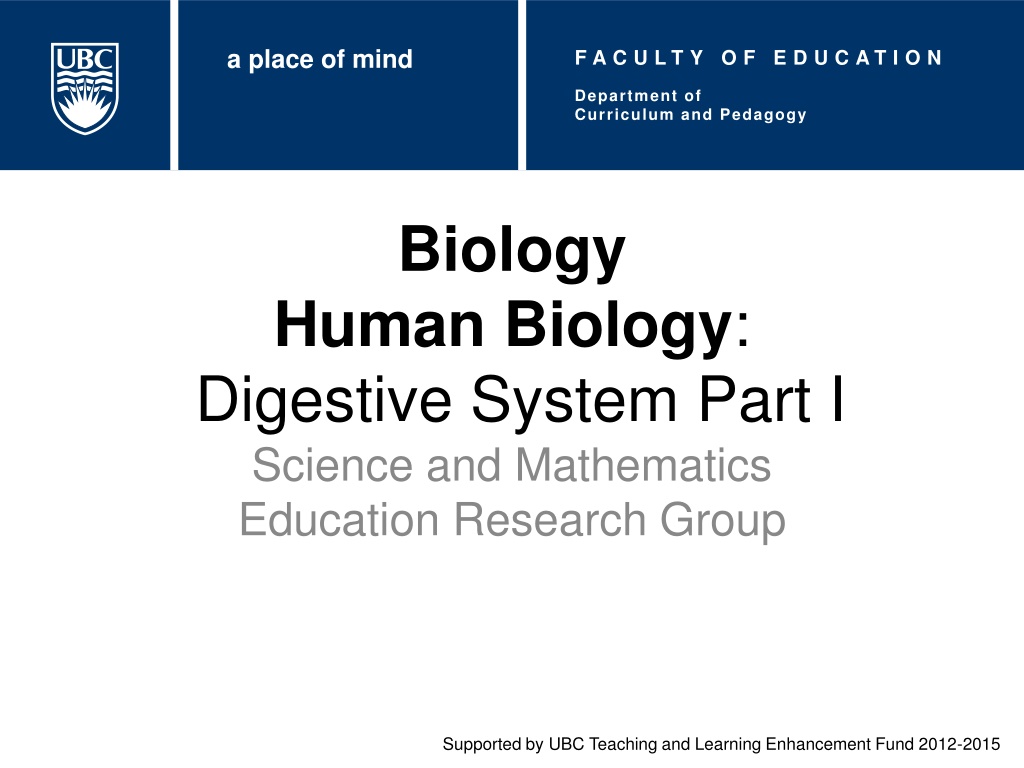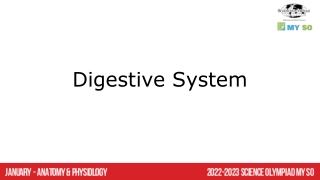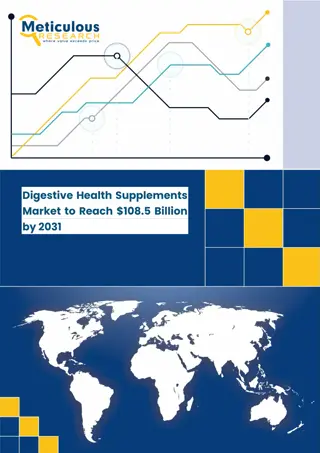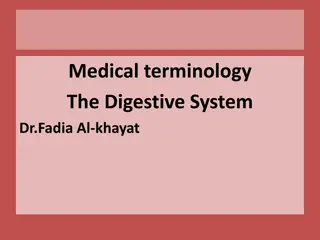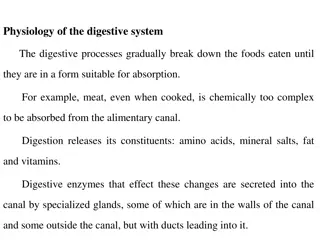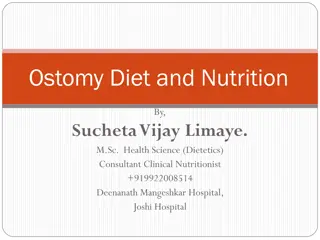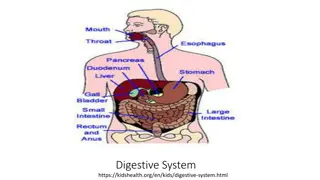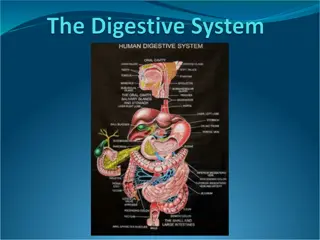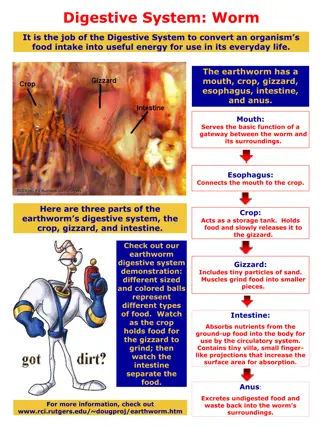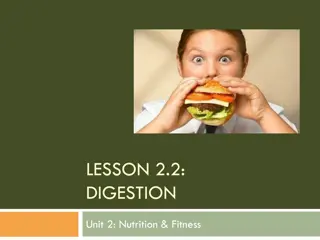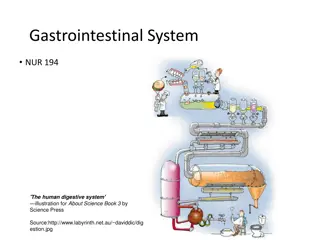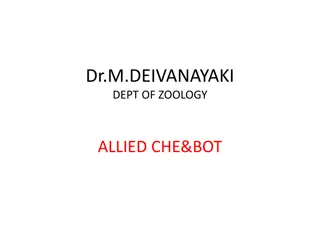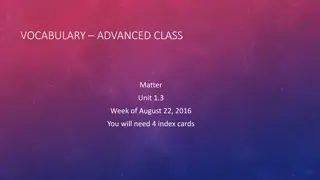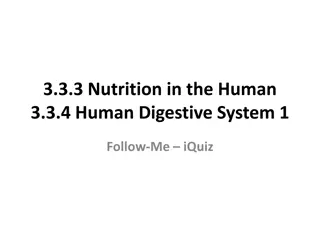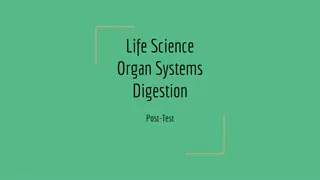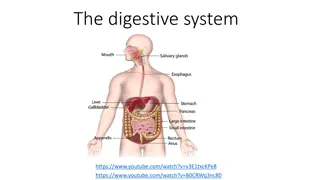Understanding the Human Digestive System: Physical and Chemical Processes Explored
Explore the intricate workings of the human digestive system, focusing on both physical and chemical digestion processes. Learn about the structures involved, such as the mouth, stomach, and small intestine, and their roles in breaking down food for absorption. Discover how organs like the liver and large intestine contribute to digestion and nutrient absorption. Test your knowledge with questions on physical and chemical digestion to deepen your understanding of this essential bodily function.
- Human Digestive System
- Physical Digestion
- Chemical Digestion
- Biology Education
- Digestive System Anatomy
Download Presentation

Please find below an Image/Link to download the presentation.
The content on the website is provided AS IS for your information and personal use only. It may not be sold, licensed, or shared on other websites without obtaining consent from the author. Download presentation by click this link. If you encounter any issues during the download, it is possible that the publisher has removed the file from their server.
E N D
Presentation Transcript
a place of mind F A C U L T Y O F E D U C A T I O N Department of Curriculum and Pedagogy Biology Human Biology: Digestive System Part I Science and Mathematics Education Research Group Supported by UBC Teaching and Learning Enhancement Fund 2012-2015
Question I Physical digestion involves physically breaking the food into smaller pieces without chemically changing it into different molecules. Which of the following does NOT serve as a physical digestion structure? A. Large Intestine B. Teeth Think about how the food goes down C. Stomach D. Tongue E. Small Intestine
Solution I Answer: A Justification: The two main structures that are physically involved with digesting food in the mouth are the teeth and tongue. The teeth cut, pierce, crush and grind the food and the tongue helps in chewing and swallowing. The stomach is a muscular storage organ that is both physically and chemically involved with digestion. The physical digestive function of the stomach is to churn the food. The small intestine is also both physically and chemically involved with digestion. Physical digestive occurs inside the small intestine when its villi and microvilli help separate food particles. The large intestine is the correct answer, because its role in the digestive system is absorption, not digestion.
Question II Chemical digestion is the breaking down of large molecules, such as proteins, starch and fats, into smaller soluble molecules for easy absorption by the human body. Which of the following does NOT play a role in chemical digestion? A. Liver B. Large intestine C. Mouth D. Stomach E. Small intestine
Solution Answer: B Justification: Chemical digestion structures are Mouth: uses amylase enzymes (contained in saliva) to break up food. Stomach: a ball of food (bolus) travels down the esophagus into the stomach and mixes with gastric juice (containing hydrochloric acid and digestive enzymes such as pepsin and rennin), which breaks down the food. Liver: produces bile, a digestive enzyme that is passed to the small intestine. Small intestine: using digestive enzymes from the pancreas and the liver, the small intestine completes the digestive process. *The large intestine serves to extract water, salts and vitamins from solid waste before it is removed from the body
Question III Fill in the blanks below with the correct answer. Food passes from the to the to the and then to the stomach, where gastric juices break up proteins and other molecules. From the , where nutrients are absorbed into the body`s bloodstream. Undigested material moves into the reabsorbed and the residual materials are compacted. , food passes to the , where water is A. Mouth Pharynx Esophagus Stomach Large intestine Colon B. Mouth Esophagus Pharynx Stomach Large intestine Small intestine C. Mouth Esophagus Pharynx Stomach Small intestine Colon D. Mouth Pharynx Esophagus Stomach Small intestine Large intestine E. Mouth Esophagus Stomach Small intestine Large Intestine - Colon
Solution III Answer: D Justification: Food passes from the Mouth to the Pharynx to the Esophagus and then to the stomach, where gastric juices break up proteins and other molecules. From the Stomach, food passes to the Small intestine, where nutrients are absorbed into the body`s bloodstream. Undigested material moves into the Large intestine (or Colon), where water is reabsorbed and the residual materials are compacted. FYI.. YouTube Video: Digestion in Human Beings 3D CBSE Class 7 Science https://www.youtube.com/watch?v=zr4onA2k_LY
Question IV In the digestive system, solid waste leaves the body through the rectum then the anus. Liquid waste leaves the body after passing through the ... A. Small intestine and bladder B. Large intestine and anus C. Kidney and bladder D. Blood vessels and lungs E. Small intestine and anus
Solution IV Answer: C Justification: The correct answer is C. As blood flows through the kidneys, the kidneys filter the blood to produce urine a liquid composed of wastes and extra fluid. From there, this urine goes to the bladder and leaves the body through a pathway called the urethra.
Question V Digestion begins in the mouth. Which of the following statements is INCORRECT? A. The saliva acts on the starches in the food, breaking it into maltose. B. The tongue keeps the food in place in the mouth while the food is being chewed. C. The digestive juices can react more easily with the food when chewed. D. The tongue helps in the chemical digestion of the food. E. The teeth, tongue, and saliva act together to make a bolus (ball of food in the mouth).
Solution Answer: D Justification: The correct answer is D. The tongue enables people to taste food and helps in chewing and swallowing (physical digestion) but it does not affect the chemical digestion process. For your information... Saliva contains the enzyme amylase which digests starch, breaking it into maltose. The digestive juices can react more easily with smaller pieces of food, because there is a larger surface area with which they can interact. The bolus is the resulting ball of food formed in the mouth through the actions of the teeth, tongue, and saliva.
Digestive System For more information: Human Digestive system - YouTube https://www.youtube.com/watch?v=b20VRR9C37Q
